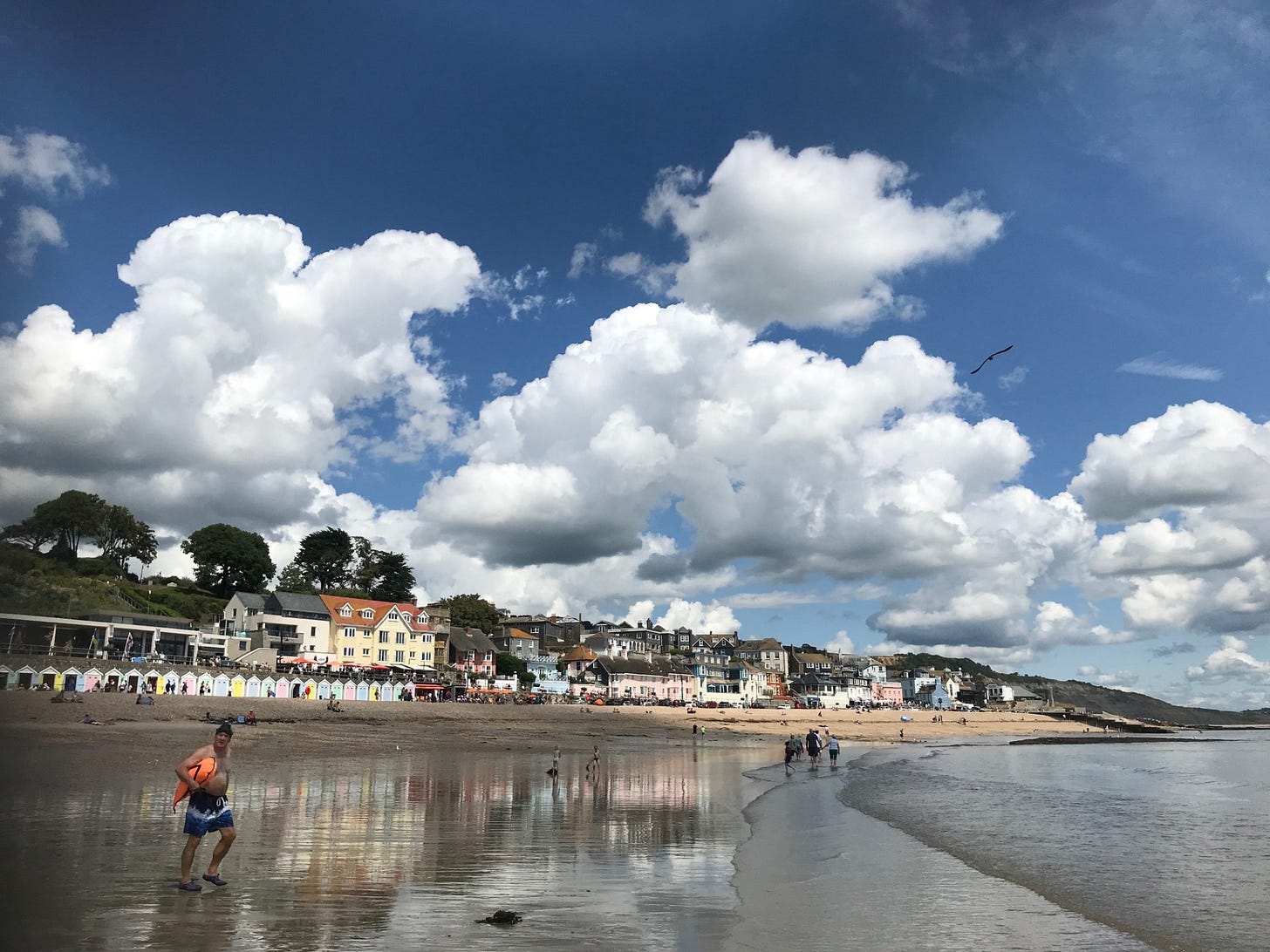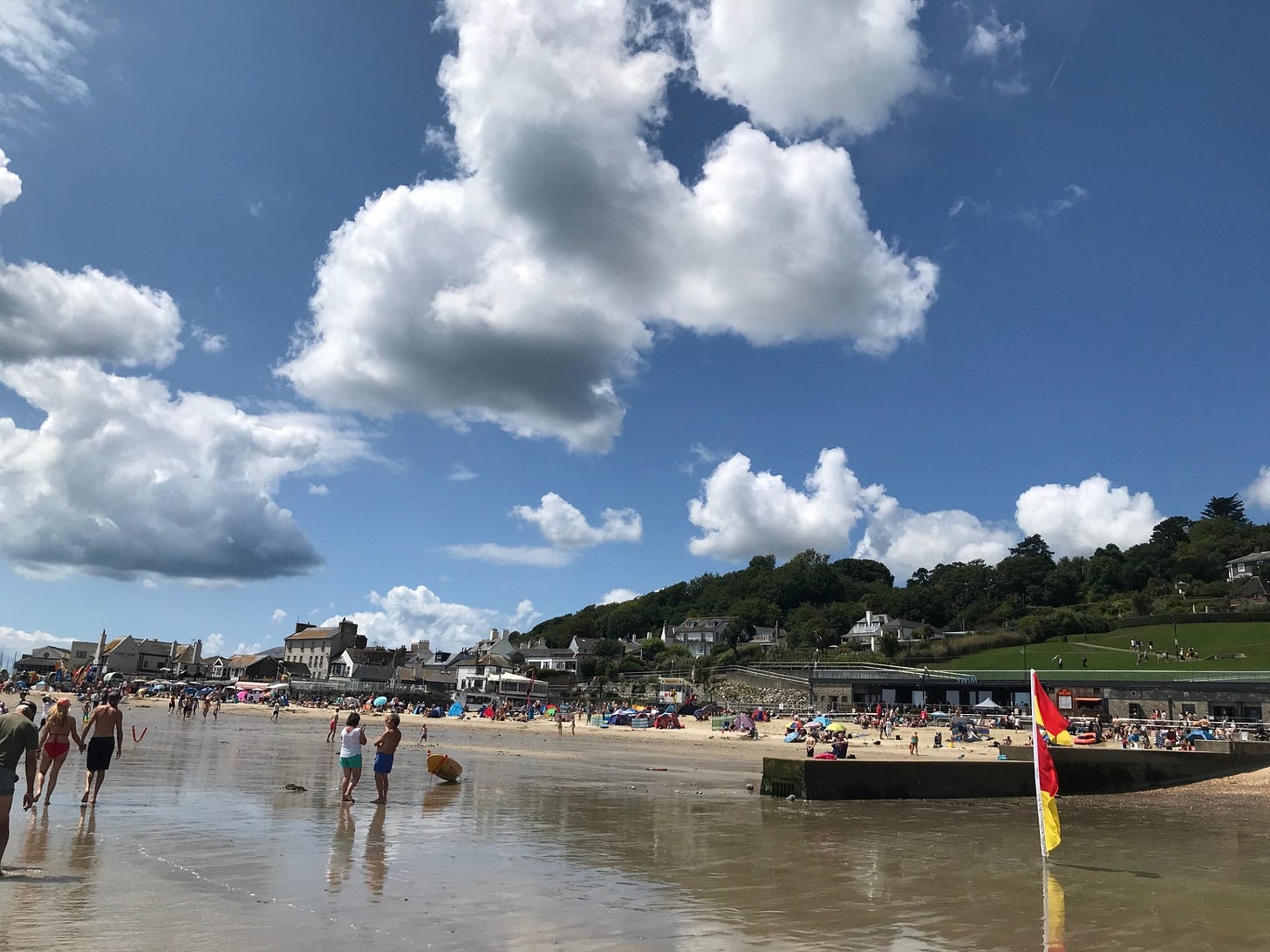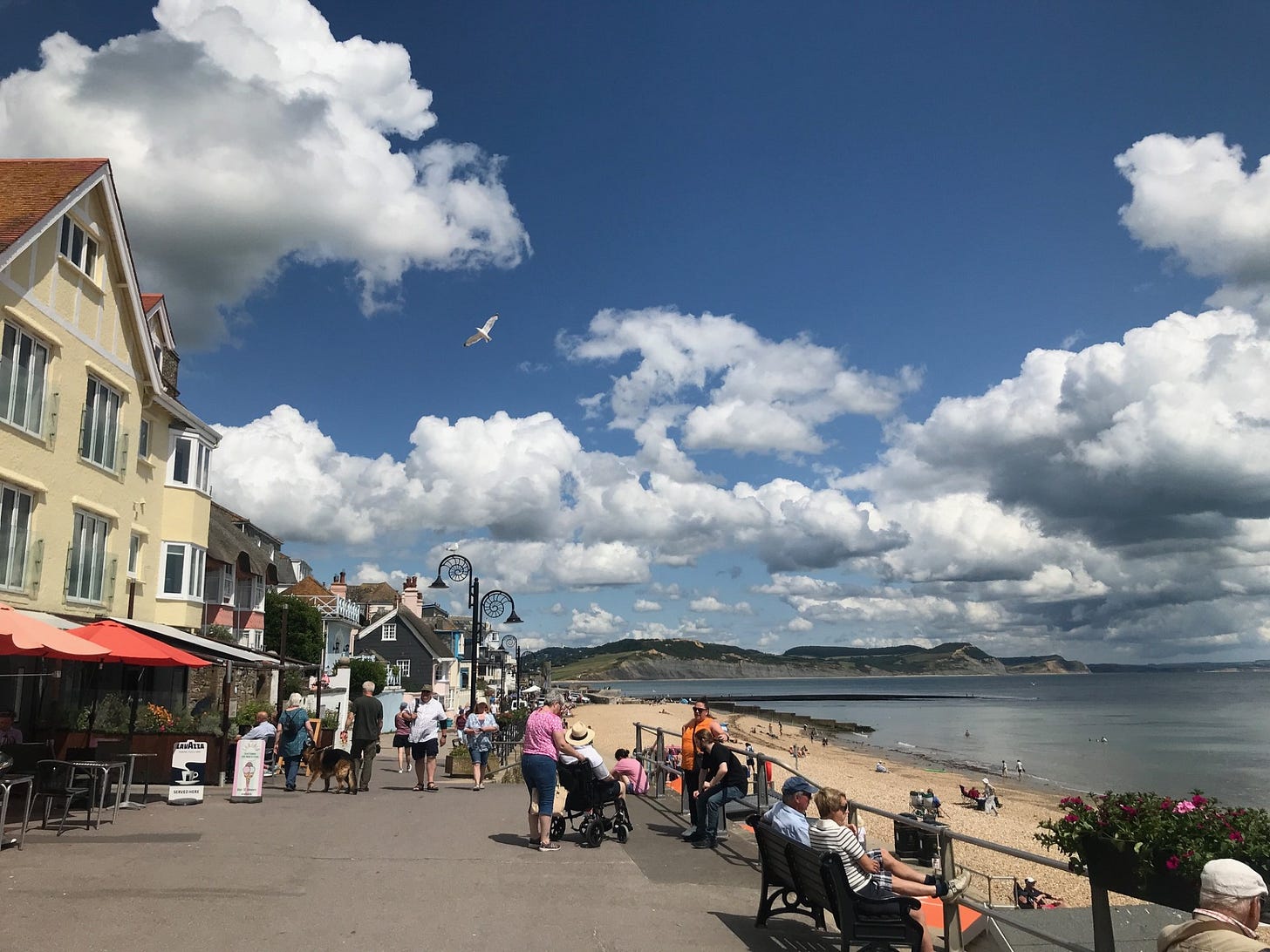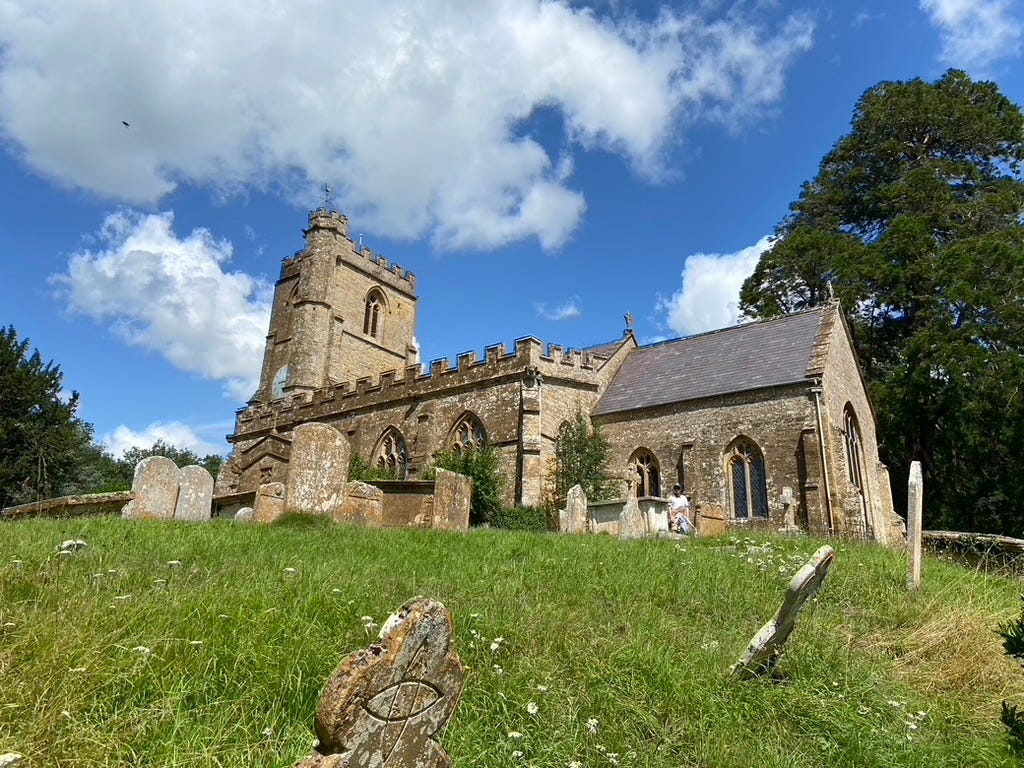Ever since I heard this episode of Backlisted I’ve been trying to find All The Devils Are Here by David Seabrook in an op shop or second-hand book shop while I’m here in England. The books sounds completely beguiling: dark and atmospheric and odd. Perfect for reading while in a seaside town. I’ve had no luck so far (and honestly don’t expect to) but the foraging mission itself is so much fun. I’ve picked up a Philip Pullman novel that I’d never heard of called Count Karlstein; Odd and the Frost Giants by Neil Gaiman (for Charlie, my son); and Nature Cure by Richard Mabey who is a writer I’ve always loved but had never got around to this one, his classic. I’m trying to read and leave them behind me: book swapping my way around the Devon — Dorset coastline.
We’ve spent over a week in Uplyme, up the river from Lyme Regis, one of my favourite places in the world. I first came here ten years ago when I was a worker on an organic farm beside River Cottage (where it was then. I think Hugh Fearnley-Whittingstall has moved it since). On our days off, me and a couple of the other young farmers walked down country, over the fields, trying to avoid the hallways of stinging nettle, alongside the river Lim to Lyme’s pebbly beach. We’d swim in the bracing water and then eat fish and chips. I came back here again in 2017 and stayed in Harcombe Bottom (a little hamlet surrounded by woods, also up from Lyme) and ran down to the beach every day to swim and then run back.
This latest trip has been about converting my family into Lyme-lovers, too. I think my son is sold due to the number of ice-cream shops along the beachfront; and my partner liked running in the woods, spying goshawks, and walking the Cobb (the medieval port that curls out from Lyme and into the sea like an ammonite).
I’ve come to adore Lyme and its surrounds even more deeply than I did before. There’s something about a beachside town, especially one as old as this. The way the stone buildings fall down the valley and cluster on the edge of the sand. It’s so optimistic. Like they’re positioning themselves to always have their sights on the horizon where everything and anything could happen.
The colours of Lyme are buoyant pastel pinks, and yellows and pale blue. Then there’s the dogs. Jesus they love dogs in the UK. But none more so than Lyme, where dogs bark and sniff each other with excitement beyond even the kids being allowed their fifth ice-cream of the week. Dogs of Lyme are entirely their own community: gesturing and conversing with tails and noses and noise. I suspect Lyme would feel different again if you were accompanying a dog. The tugging and the stooping to collect their shit (thankfully, most people seem to be diligent about this.).
But there’s something else beyond the aesthetics, behind the sheer prettiness of it. There’s the evergreen nerdery of the fossil hunt: enthusiasts and freshies alike pouring over the samples in the Mary Anning Museum (actually called the Lyme Regis Museum but I can’t kick my habit), before heading out to try their luck on this stretch of Jurassic Coast (Triassic, too). Then there’s the persistence of the majestic seagulls who have grown supremely savvy. They can dive bomb so accurately they can pluck the remaining bites of a person’s sandwich right out of their hands (happened to me). The eccentric second-hand bookshop — that’s run out of Austen, and only takes cash and is jammed with quirky ornaments and original movies posters for The French Lieutenant’s Woman which you can take home for a cool 99 quid — is perfection.
Lyme Regis is small but it teems with life. All kinds of it. Elderly couples and groups of friends lined up to eat ice cream and stare out to sea; families nestled into the stones with striped towels and little pop-up tents and fences for shade; a sturdy line-up of colourful beach huts that remind me of that miraculous novel, The Fortnight in September; cream teas dished out and Cornish pasties reheated up and down the sloping main street; paddle boarders and kayakers carving gentle curves around the bay; and a pot-bellied man, shirt off, skin brown as a nut, hocking jumps on a huge trampoline for 2 quid per fifteen minutes.
Whole industries clinging to the edge of the water, hoping for sun to keep the money flowing, hoping for fish to keep the fryers bubbling, needing the power bills to stop climbing. There’s fragility everywhere. Even in a place as popular as Lyme Regis you can see where things could be hurting. Shop keepers seem tired, a few aren’t opening their doors even at this most peakest of Summer weeks. Things are a lot more expensive than they were a decade a go. I buy an espresso for three pounds and it sits pathetically in the bottom of the paper cup like a muddy puddle.
Still, it’s beautiful. So beautiful to be here again. Despite the savage gulls, and the sense of erosion between things — or maybe it’s because of that — I’m inspired by this place: I feel like making festivals again. Something I haven’t had energy for a few years. I want to talk about the sea, and the places that set up beside it, and the people who keep the stone warm. I want to bring writers together who have watched, and swum, and surfed, and shouted about the foreshore, and fisheries, and what will happen to it all.
There is a part of me that wonders if this place is in my blood. While we’re near, we visited Netherbury, about a 20 minute drive from Lyme, back inland, into Dorset. Netherbury is a tiny village, full of old stone cottages, and large ones, and old roses and apple orchards and bursts of daisy bushes. It feels like a secret, hidden from main roads and opening out only after you’ve squeezed through hedgerows so tall they’d be double my height.
St Mary’s church to the side of the village is immaculately kept. Strangely so, to my heathen eyes. The grass is freshly mown, the pathways are clean and clear. The gravestones are mostly very old and hard to read but even they seem tidy. We’ve come here because this is where my ancestors departed from to come to Aotearoa. I never used to think about this much, though I did visit once before. I was hitchhiking and remember enjoying the pub down the road more than anything else.
This time was different. We found a Mabey in the graveyard and I had Charlie with me. I explained that a very long time ago people we are related to lived here and were farm labourers. It must have been muddy, I suggested. And their bosses probably lived in the unimaginably huge manor house up the private driveway.
It is a beautiful village. I could live there, I think. If I could get to Lyme easily, and the sea. I found myself trying to imagine Job and Rachel Mabey, and Charles and Elizabeth Mabey making the journey to the beach. There was an old cart inside the church: sleek and wooden and well preserved. But what a trip it would have been: bumpy and long and hard on the bottom. I have a feeling they probably had too much dirty work to do. Why else would they have left? To go so far in a ship, and lose a child on the way, only to steal land and set up another church in a country they were so unconnected to. It makes me think Netherbury wasn’t anywhere near the idyllic little secret it seems now.
For now we’re staying close to the sea. In Devon this time, where we can head into Dartmoor and visit ancient sites. But we’ll be going back to Lyme just one more time. So I can try and fix it in my brain and let it fuel me for a while to come.










Love this, Claire. My fixation with England is fully satisfied reading about the villages and I totally look forward to Devon and Dartmoor cos we spent a lot of time there
I hope you got to Dartmouth, it’s rather lovely. We used to spend time there in eighties. I’d feel about Dartmouth like you do about Lyme Regis. I wish excellent travels to you xx